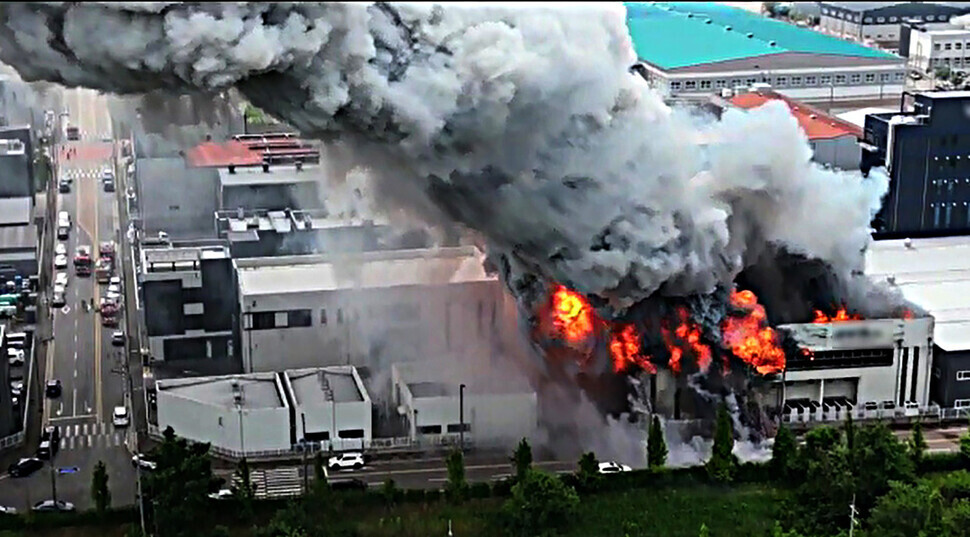hankyoreh
Links to other country sites 다른 나라 사이트 링크
[Editorial] Workplace hazards can be prevented — why weren’t they this time?

A fire broke out at a lithium battery factory in Hwaseong, Gyeonggi Province, on Monday morning, killing at least 22 and injuring eight. One person is still reported as missing (as of 6:30 pm on Monday). This marks a horrific mass tragedy.
It is reported that 20 of the victims were migrant workers from China, Laos, and other countries. The wounds left by the 2020 fire at the construction site of a logistics center in Icheon, Gyeonggi Province, which killed 38 people, had only just begun to heal before we experienced yet another repetition of a tragedy that could’ve been prevented.
The fire started on the second floor of a factory building where finished lithium batteries are inspected and packaged, and spread uncontrollably following a chain of explosions. More than 35,000 lithium batteries were stored at that location.
When a lithium battery catches fire, it triggers a thermal runaway, in which the temperature instantly soars to more than 1,000 degrees Celsius, as well as producing large amounts of hydrogen fluoride gas. Hydrogen gas is produced if water comes into contact with the batteries in that state, which can lead to secondary explosions, making it difficult to extinguish fires in the traditional way.
Firefighters had prepared dry sand and nitrogen gas to extinguish the fire caused by the lithium batteries, but as they were unable to control the raging flames, they had to wait almost four hours before starting their rescue operation.
Above all, there is no apt way of expressing the horror of learning that evacuations did not take place in the early stages of the fire, leading to a tragedy that took the lives of so many individuals.
No matter how quickly the fire spread, it does not make sense that more than 20 people were killed before they could evacuate. Bodies of workers were found scattered around the second floor of the building, which was where the fire started. Despite the fact that there was an emergency staircase that led to the first floor, too many lives were lost. One cannot help but begin to wonder whether precautionary safety measures had been taken, such as fire evacuation training for the migrant workers.
The dangers of lithium battery fires are well known in the industry, which means that sufficient prevention measures should have taken place. As authorities investigate, it will be necessary to thoroughly check whether the safety management regulations for the workplace, which handled a hazardous material in the form of lithium batteries, were sufficient and whether the relevant regulations were properly adhered to.
We need to see if the workplace was up to code with the Occupational Safety and Health Act, as well as seeing if violations of the Serious Accidents Punishment Act, which was expanded to cover workplaces with more than five employees and less than 50 in January, took place and if so, make sure that those responsible are held accountable.
If we don’t establish a workplace culture that involves carefully checking for various hazards lurking in our workplaces, we never know when we’ll be hit with another unexpected tragedy. We must not continue the vicious cycle of taking measures only after lives are lost. Support for the families of those lost in the fire, as well as treatment of those who were injured, should not be neglected.
Please direct questions or comments to [english@hani.co.kr]

Editorial・opinion
![[Column] How opposing war became a far-right policy [Column] How opposing war became a far-right policy](https://flexible.img.hani.co.kr/flexible/normal/500/300/imgdb/original/2024/0702/5017199091002075.jpg) [Column] How opposing war became a far-right policy
[Column] How opposing war became a far-right policy![[Editorial] Korea needs to adjust diplomatic course in preparation for a Trump comeback [Editorial] Korea needs to adjust diplomatic course in preparation for a Trump comeback](https://flexible.img.hani.co.kr/flexible/normal/500/300/imgdb/original/2024/0702/9717199086060096.jpg) [Editorial] Korea needs to adjust diplomatic course in preparation for a Trump comeback
[Editorial] Korea needs to adjust diplomatic course in preparation for a Trump comeback- [Editorial] Silence won’t save Yoon
- [Column] The miscalculations that started the Korean War mustn’t be repeated
- [Correspondent’s column] China-Europe relations tested once more by EV war
- [Correspondent’s column] Who really created the new ‘axis of evil’?
- [Editorial] Exploiting foreign domestic workers won’t solve Korea’s birth rate problem
- [Column] Kim and Putin’s new world order
- [Editorial] Workplace hazards can be prevented — why weren’t they this time?
- [Editorial] Seoul failed to use diplomacy with Moscow — now it’s resorting to threats
Most viewed articles
- 110 days of torture: Korean mental patient’s restraints only removed after death
- 2[Editorial] Korea needs to adjust diplomatic course in preparation for a Trump comeback
- 3Nine dead in Seoul after car plows into pedestrians
- 4[Column] How opposing war became a far-right policy
- 5Japan is building a military meant for more than self-defense — and has the US to thank for it
- 6Samsung Electronics workers to go on first strike in company’s 55-year history
- 7Korea to create dedicated population strategy ministry to combat low birth rate, aging society
- 8S. Korea joins US, Japan for first multi-domain drills at a time of escalating tensions
- 9[Column] The miscalculations that started the Korean War mustn’t be repeated
- 10Nepotism remains prevalent at Korean chaebols